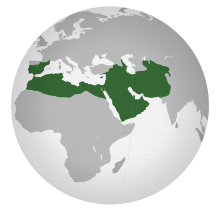Hisham II
| Hisham II ھشام المؤيد بالله | |
|---|---|
.jpg) Dirham of Hisham II, minted in Córdoba in 393 AH (1002 AD) | |
| 17 Caliph of Umayyad Dynasty 3rd Caliph of Córdoba | |
| Reign |
16 October 976–1009 1010– 19 April 1013 |
| Predecessor |
Al-Hakam II Sulayman ibn al-Hakam |
| Successor |
Muhammad II Sulayman ibn al-Hakam |
| Born |
966 Cordoba |
| Died |
April 19, 1013 (aged 46–47) Cordoba |
| Father | Al-Hakam II |
| Mother | Subh |
Abu'l-Walid Hisham II al-Mu'ayyad bi-llah (Arabic: أبو الوليد هشام المؤيد بالله, translit. Abū'l-Walīd Hishām al-Muʾayyad bi-ʾllāh) (son of Al-Hakam II and Subh of Cordoba) was the third Umayyad Caliph of Spain, in Al-Andalus from 976–1009, and 1010–13.[1]
In 976, at the age of 11, Hisham II succeeded his father Al-Hakam II as Caliph of Cordoba. Hisham II was a minor at the time of his accession and therefore was unfit to rule. In order to benefit the Caliphate, his mother Subh was aided by first minister Jafar al-Mushafi to act as regents with al-Mansur ibn Abi Aamir (better known as "Almanzor") as her steward. In 978 Almanzor manipulated his way into the position of royal chamberlain. In an attempt to position himself as a prospective ruler of the Caliphate, Almanzor and General Ghalib al-Siklabi sabotaged the brother of Al-Hakam II who was set to succeed his brother and become the next Caliph of Cordoba. Too young to rule, Hisham II handed his political reins of power over to Almanzor in 981 who became the de facto leader of the Caliphate until his death in 1002.[2] Al-Mansur ibn Abi Amir perpetuated his position as the omnipotent ruler in charge of the empire while he exiled Hisham II and essentially kept him prisoner leaving him impotent for most of his reign as the third Caliph of Cordoba. With his countless successful campaigns against Christian powers in the Spanish North such as Barcelona in 985, León in 988, as well as a major strike on the church of St. James in the Galician city of Santiago de Compostela in 998,[3] Almanzor is known for bringing the Caliphate of Córdoba to its apex of power in Islamic Iberian history.
In 1002, after the death of his father (Almanzor), Abd al-Malik (1002–1008) became the ruler of the Caliphate and led successful campaigns against Navarre and Barcelona. In 1008 Abd ur-Rahman Sangul (1008–1009) is said to have poisoned his brother (Abd al-Malik al-Muzaffar) which led to his death in October 1008.[4] In 1009, while Abd al-Rahman Sanchuelo was waging war against Alfonso V in León, Muhammad II al-Mahdi usurped the throne from Hisham II then held him hostage in Cordoba. In November of the same year, just months after initiating his control as the ruler of the Caliphate, Muhammad II al-Mahdi was overthrown by a primarily Berber army (that he had previously commanded, but by which he was later abandoned) which was led by Sulayman ibn al-Hakam in the battle of Alcolea. After the battle, Abd al-Malik al-Muzaffar was exiled to Toledo at which point Sulayman laid siege to Cordoba freeing Hisham II from the imprisonment that took place under the rule of Muhammad II al-Mahdi. Sulayman ibn al-Hakam was appointed to Caliph by his Berber army and maintained that position until Muhammad II al-Mahdi re-conquered the territory in May, 1010. Finally the Slavic troops of the Caliphate under al-Wahdid restored Hisham II as Caliph (1010–1013).
Hisham II was now under the influence of al-Wahdid, who was nevertheless unable to gain control of the Berber troops - these still supported Sulayman, and the civil war continued. It is known that Hisham "openly kept a male harem."[5] In 1013 the Berbers took Cordoba with much plundering and destruction. What happened to Hisham after that is uncertain – supposedly he was killed on 19 April 1013 by the Berbers. In any case, Sulayman al-Mustain (1013–1016) became Caliph.[6]
See also
References
- ↑ "First Encyclopaedia of Islam: 1913-1936, Volume 3". Retrieved 25 September 2016.
- ↑ Clarke, Nicola (2016-01-02). "Heirs and Spares: Elite Fathers and Their Sons in the Literary Sources of Umayyad Iberia". Al-Masāq. 28 (1): 67–83. doi:10.1080/09503110.2016.1152805. ISSN 0950-3110.
- ↑ "al- Mansur, 914–1002, Moorish regent of Córdoba: Discovery Service for Loyola Marymount Univ". eds.b.ebscohost.com. Retrieved 2016-12-13.
- ↑ "Ibn Ḥazm of Cordoba : The Life and Works of a Controversial Thinker". eds.b.ebscohost.com. Retrieved 2016-12-13.
- ↑ Daniel Eisenberg, “Homosexuality” in Medieval Iberia: An Encyclopedia, ed. Michael Gerli (Routledge, 2003), 398.
- ↑ "The Cambridge Medieval History vol 3 - Germany and the Western Empire". Retrieved 25 September 2016.
External links
- Al-Andalus: the art of Islamic Spain, an exhibition catalog from The Metropolitan Museum of Art (fully available online as PDF), which contains material on Hisham II (see index)
Hisham II Cadet branch of the Banu Quraish | ||
| Preceded by al-Hakam II |
Caliph of Córdoba 976–1009 |
Succeeded by Muhammad II |
| Preceded by Sulayman ibn al-Hakam |
Caliph of Córdoba 1010–1013 |
Succeeded by Sulayman ibn al-Hakam |
